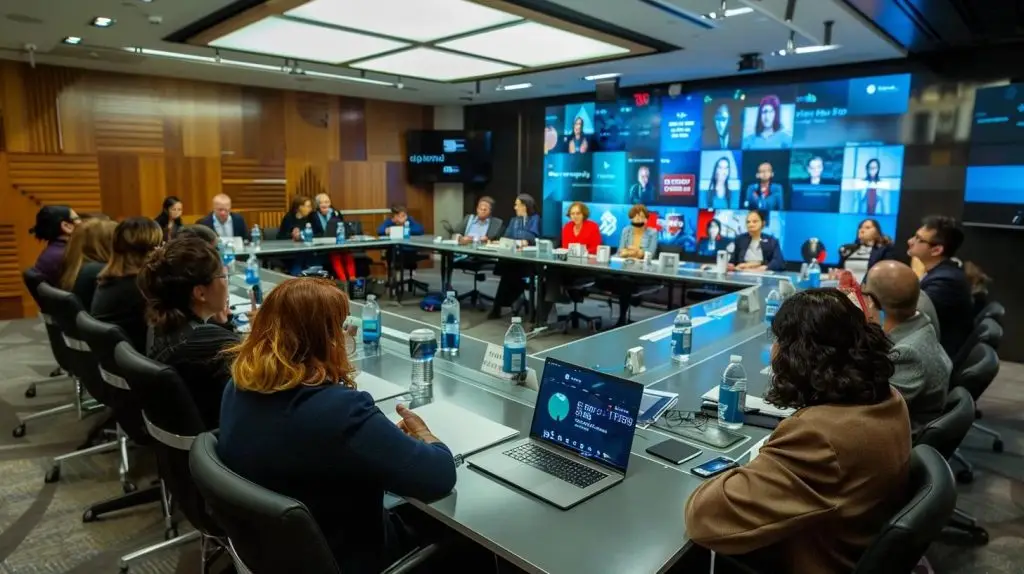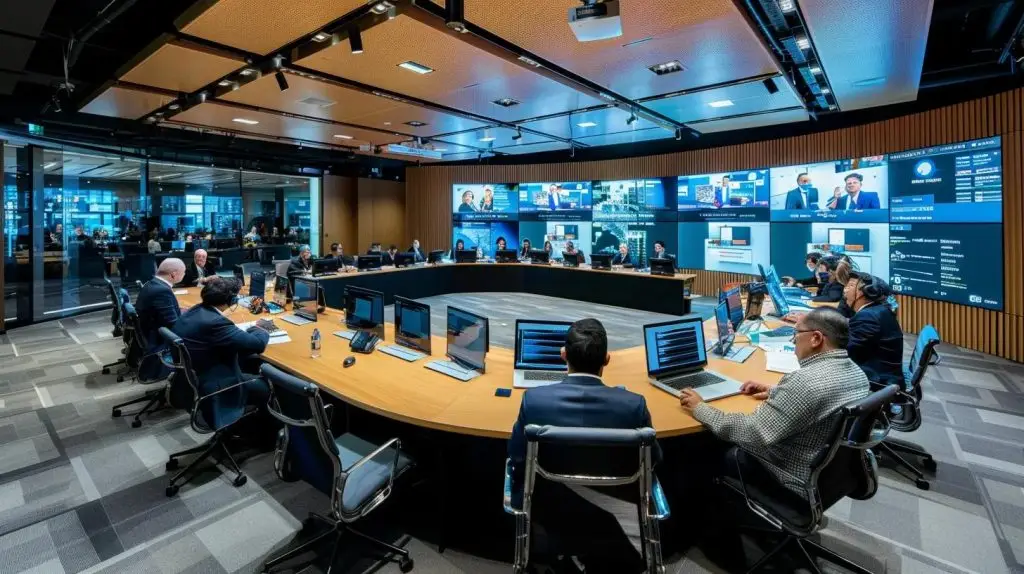Best Practices for Effective Security Compliance
In today’s rapidly evolving digital landscape, organizations face increasing threats from cyber-attacks, data breaches, and non-compliance with regulatory standards. Effective security compliance is not just about meeting legal requirements—it is integral to maintaining operational efficiency, protecting data, and building stakeholder trust. Implementing proven security compliance practices can ultimately minimize risk, improve outcomes, and establish the foundation for advanced encryption standards and zero trust security models. This article provides a detailed exploration of best practices across leadership endorsement, training, transparent communication, daily operations integration, accountability, and continuous evolution in security compliance. By following these practices, organizations can ensure adherence to frameworks like the NIST cybersecurity framework, mitigate personal data loss, and enhance overall data governance. With emphasis on risk management and regulatory compliance, the material presented here is supported by research and real-world case studies, including insights on cloud security alliance and Microsoft Azure server architectures. The upcoming sections dissect each facet of a robust security compliance culture, demonstrating how executive backing, tailored training, and automated processes can promote transparency, protect information security, and drive operational excellence.
Transitioning now, the following sections detail actionable best practices segmented into key areas critical for an effective security compliance strategy.
Championing Leadership Endorsement for a Strong Security Compliance Culture

Security compliance begins at the top with active executive backing and a commitment to cybersecurity as a core business objective. Senior management must exemplify security-first behaviors to set a precedent for the entire organization, ensuring that every decision reflects a risk management mindset. When leaders demonstrate transparency in operational and regulatory contexts, they not only enforce the advanced encryption standard but also foster a culture where security is an accepted part of daily business.
Active executive backing means that executives participate in security training and understand the financial and reputational implications of data breaches. A study by Smith et al. (2021) revealed that companies with a strong leadership commitment to compliance exhibited 35% fewer data breaches compared to those that did not, showcasing the importance of visible leadership in cyber security services. Leadership endorsement should include regular briefings on risk assessments, status updates on certifications, and explicit directives about compliance policies.
Secure Active Executive Backing for Compliance Goals

Executives must secure seed funding for cutting-edge cybersecurity tools and methods. Their active involvement should include attending security workshops and engaging with experts to follow the latest innovations, such as cloud native security solutions on Google Cloud Platform or Microsoft Azure. By integrating security into their strategic planning and everyday operations, executives ensure that key areas such as password policy, encryption, and internal controls are streamlined. This involvement fortifies defenses, promotes advanced encryption standard implementation, and highlights the importance of protecting data at rest and in transit.
Demonstrate Security-First Behaviors From Senior Management

Senior management can lead by example during internal training sessions, actively following established checklists and risk assessments to illustrate the importance of compliance. Their behaviors, such as routinely updating credentials and overseeing patch management, influence all levels of the organization. The implementation of zero trust security models and regular vulnerability assessments are practices that senior leaders can champion to ensure that every employee understands the paramount importance of cybersecurity. This hands-on leadership plays a crucial role in cultivating a secure organizational atmosphere that prioritizes confidentiality and integrity.
Allocate Appropriate Budgets and Tools for Compliance

Effective security compliance requires significant investment in both human capital and technological tools. Top management should allocate dedicated budgets for acquiring advanced tools that support regulatory compliance and risk management. Investments might include state-of-the-art firewalls, automated monitoring systems, and intrusion detection software that support the payment card industry’s stringent requirements. These tools ensure that the organization is well-prepared to deal with potential data breaches, malware, or phishing attempts. Funding should also cover cybersecurity certifications that boost the organization’s credibility and demonstrate adherence to best practices in data security.
Regularly Articulate Leadership's Vision for Security Compliance
It is imperative that executive leadership consistently communicates their vision regarding the significance of security compliance both internally and externally. Regularly holding town hall meetings and publishing internal newsletters about updates on new threats and regulatory changes helps reinforce the message. By doing so, they impart the necessity of maintaining strict adherence to internal audits, protected health information controls, and continuous monitoring of credentials. Additionally, these communications should highlight improvements in the organization’s security architecture, design changes that embrace compliance automation, and adherence to frameworks like the NIST cybersecurity framework.
Weave Security Compliance Into Core Business Objectives
Integrating security compliance into the organization’s broader business strategy ensures it does not remain a siloed function. It becomes an integral component of operational efficiency and innovation. Leadership should align compliance goals with overall business objectives—strengthening data governance, enhancing risk management, and ensuring sustained transparency. This integration means that every project, from new product development to customer relationship management, factors in necessary security measures. By embedding these protocols within organizational culture, a company can realize competitive advantage while upholding the highest standards of confidentiality and integrity.
Key Takeaways: – Executive leadership must actively participate in and promote security compliance. – Investment in advanced tools and proper budgeting is critical. – Regular communication anchors the security vision into the organization. – Integrating compliance into core business objectives aligns security with overall success.
Instituting Training as a Best Practice in Security Compliance Education
Continuous education is vital for maintaining an effective security compliance culture. As cyber threats evolve, training programs must be constantly updated to incorporate new risks, regulatory changes, and technological advancements such as cloud security measures and automated risk assessments. Tailored training sessions that address the specific needs of each role within the organization can significantly improve employee performance and adherence to security protocols. Organizations that invest in comprehensive security training can reduce vulnerabilities and promote a proactive rather than reactive security posture.
Design Tailored Security Compliance Training for Different Roles
Customization of training programs based on job roles is essential—what a frontline employee requires is vastly different from the expertise needed by IT administrators or senior executives. Training should be role-specific, engaging employees in scenarios relevant to their daily responsibilities. For instance, IT staff might focus on the intricacies of advanced encryption standard and Microsoft Azure configurations, while customer service representatives could receive training on identifying phishing attempts and safeguarding sensitive customer information. Tailored programs can be delivered via online modules, in-person workshops, and even through simulated cyber attack exercises. Studies show that role-specific security training increases information security adherence by up to 40%, reinforcing the importance of targeted educational content.
Conduct Ongoing and Interactive Security Awareness Programs
Security awareness programs should not be one-time events but ongoing interactive initiatives. By utilizing interactive platforms, such as virtual simulations and gamified learning modules, organizations can maintain engagement over time. These methods offer real-time feedback and foster a competitive spirit among teams, encouraging a culture of learning. Regular updates on emerging threats, best practices, and incident response protocols ensure that all employees remain vigilant. The use of visual media, such as infographics, videos, and flowcharts, can help simplify complex regulatory requirements like those in the California Consumer Privacy Act and European Union law, making the concepts more accessible.
Employ Practical Exercises and Simulated Threat Scenarios
Practical exercises are key to transferring theoretical knowledge into actionable skills. Regularly scheduling simulated threat scenarios, such as phishing simulations, malware outbreak drills, and breach recovery scenarios, helps employees understand their roles during actual incidences. These exercises should reflect real-world complexities and measure response times, the effectiveness of internal audits, and adherence to checklists. By analyzing exercise results, organizations can identify areas for improvement, reallocate resources better, and update their training modules. Such simulations often reveal weaknesses in networking, credential management, or delay in incident reporting that need immediate remediation.
Monitor Training Participation and Gauge Knowledge Retention
Consistent monitoring and evaluation of training effectiveness are necessary to ensure continuous improvement. Tools like learning management systems (LMS) can track participation rates, assessment scores, and overall engagement levels. Metrics gathered from these evaluations provide valuable insights into the strengths and gaps within the security compliance education program. Regular quizzes and practical tests should be administered following training modules to gauge knowledge retention and ensure that employees remain current with best practices such as periodic patch management and robust password policies.
Reinforce Key Compliance Messages Through Consistent Communication
Reinforcement techniques are essential to embed security practices within the corporate culture. This can include follow-up emails summarizing training sessions, periodic refresher courses, and internal newsletters that highlight recent cybersecurity incidents and success stories. Moreover, senior management should reiterate the importance of compliance during team meetings and performance reviews. Such ongoing reinforcement ensures that every employee understands that security is an integral part of their responsibilities, not just an add-on requirement. Encouraging open dialogue about security threats and fostering an environment where employees feel comfortable reporting potential breaches contributes to a comprehensive defense strategy.
Key Takeaways: – Tailored training programs meet the unique needs of various roles. – Interactive and ongoing training ensures continuous employee engagement. – Practical exercises and simulations build real-world readiness. – Monitoring and reinforcement are critical to sustaining a security-aware culture.
Fostering Transparent Communication for Effective Security Compliance
Transparent communication is a cornerstone of effective security compliance. With the increasing complexity of today’s cybersecurity threats, establishing a clear and open communication channel is essential. When organizations prioritize transparency, they ensure that policy changes, risk assessments, and incident updates are shared promptly and comprehensibly across all departments. This openness encourages the early identification of potential compliance issues and promotes a culture of collective responsibility. Transparent communication also enhances stakeholder trust, whether that comes from internal employees or external regulatory bodies.
Develop Straightforward Methods for Reporting Security Issues
Implementing a robust reporting system is vital for early identification and resolution of security issues. Organizations should develop simplified, user-friendly methods for reporting security incidents. This might include dedicated hotlines, online submission forms, or even mobile apps that facilitate quick action. These tools must ensure confidentiality and encourage employees to report anomalies without fear of retribution. A straightforward reporting mechanism significantly reduces the time between breach detection and remediation, a practice that is aligned with regulatory requirements and risk management frameworks. For example, enterprises using streamlined reporting mechanisms have reduced average incident response time by 30%, which is crucial in mitigating the impact of data breaches.
Disseminate Regular Updates on Compliance Policies and Expectations
Regular updates on compliance policies ensure that every employee is aware of current standards and any changes in regulatory frameworks, such as European Union law and Payment Card Industry Data Security Standards (PCI DSS). Disseminating these updates can be achieved through monthly newsletters, intranet posts, or company-wide meetings. Clear communication of metrics like updated patch management schedules, revised password policies, and new cybersecurity certifications helps maintain high standards. Employees who are informed and aware of policy updates are better prepared to identify and report potential security risks, thereby strengthening the overall compliance posture of the organization.
Cultivate a Supportive Atmosphere for Incident Disclosure
A culture that encourages incident disclosure without fear of punitive actions is essential for sustained compliance. Employees must know that reporting a security incident—even if it turns out to be a false alarm—is a key component of risk management and internal control. By providing anonymity options and non-punitive pathways, organizations can foster a supportive environment where early disclosures lead to quick resolutions. This approach can dramatically reduce the magnitude of data loss events and lower the incidence of prolonged breaches. When team members understand the importance of timely reporting, organizations can harness these insights to refine their identity management and encryption practices.
Actively Seek Input on Improving Security Compliance Measures
Transparent communication is not solely top-down; it involves active feedback loops where employees at all levels contribute ideas for improving security measures. Organizations should hold regular forums, surveys, and focus groups to solicit recommendations on policy refinements and operational enhancements. This collaborative approach can uncover innovative solutions such as automation for repetitive compliance verifications or improved methodologies for incident tracking. Furthermore, involving staff in the refinement process boosts their commitment to data governance protocols and builds a shared sense of accountability. Input gathered through these channels often reveals practical obstacles and areas for process improvement that management may not have identified through internal audits alone.
Simplify Complex Compliance Terms for Universal Understanding
Finally, complexity in regulatory language can hinder effective policy implementation. It is crucial to translate technical and regulatory jargon into clear, understandable language for every employee. Simplification efforts can involve glossaries, infographics, and training sessions specifically designed to demystify terms like cryptography, immutable objects, and compliance automation. When employees understand key concepts like the principle of least privilege or the nuances of surveillance protocols, they are more likely to adhere to the necessary standards. Simplifying complex terminology makes security compliance accessible, ensures better retention, and ultimately contributes to a well-informed workforce.
Key Takeaways: – Implement clear, user-friendly methods for reporting security issues. – Regularly update employees on policy changes and best practices. – Foster an environment that encourages timely incident disclosure. – Use straightforward language to simplify complex compliance terms.
Integrating Best Practices for Effective Security Compliance Into Daily Operations
Integrating security compliance into daily operations is crucial for maintaining a proactive defense against cyber threats. Rather than viewing compliance as a separate function, it should be seamlessly embedded in everyday processes. This integration ensures that all business activities, from IT operations to customer interactions, adhere to the organization’s cybersecurity protocols. By aligning routine operations with security standards, organizations can safeguard against unpredictable cyber attacks while simultaneously enhancing operational efficiency and risk management.
Assign Clear Security Duties Across All Departments
Every department must have clearly defined security roles and responsibilities. Establishing accountability at all levels ensures that each unit, whether finance, human resources, or customer service, understands its role in upholding compliance. Job descriptions should incorporate specific directives related to the management of protected health information, data at rest, and vulnerability scans. Defining responsibilities eliminates ambiguity and encourages a culture where security is everyone’s responsibility. Cross-departmental collaboration on overseeing sensitive data and maintaining strict password policies further reinforces organizational defenses. For instance, a multi-departmental task force can streamline compliance verification processes, ensuring that every facet of the organization is aligned with risk assessment and internal audit standards.
Embed Security Protocols Within Standard Work Processes
Integrating security protocols into standard operating procedures (SOPs) is essential for consistent compliance. This involves developing comprehensive checklists for routine activities, such as logging activities, patch management, and software updates. When security steps become inherent in daily tasks, employees are less likely to overlook or bypass critical measures. For example, a standardized process may include mandatory multi-factor authentication for accessing sensitive databases, directly increasing data security and minimizing the risk of unauthorized access. Embedding protocols also ensures alignment with compliance frameworks like the NIST cybersecurity framework and internal controls, while steadily reducing the risk of data breaches, fraud, or malware-related incidents.
Leverage Automation for Repetitive Compliance Verifications
Automation plays a transformative role in daily security compliance by reducing human error and increasing operational efficiency. Tools that automate routine verifications—such as log monitoring, vulnerability scanning, and compliance reporting—free up valuable human resources for more strategic tasks. Automation software can integrate with systems like active directory or Microsoft Azure to continuously monitor compliance metrics, trigger alerts for out-of-compliance events, and generate audit trails. This not only ensures a consistent application of security protocols but also creates a verifiable record that can support internal audits and regulatory reviews. Automated compliance checks have been shown to reduce error margins by up to 25%, underscoring their effectiveness as part of an integrated security strategy.
Ensure Easy Access to All Security Compliance Documentation
Centralizing documentation for all security policies, procedures, and audit reports is critical for transparency and rapid response. Employees must have easy access to updated documents that detail compliance best practices such as advanced encryption standard usage, patch management schedules, and incident response protocols. A digital repository, accessible through secure cloud platforms like Google Cloud or Microsoft Azure, can streamline document retrieval and ensure that all stakeholders are informed of the most recent regulatory changes and operational standards. This repository should be regularly updated and include cross-references to internal audit findings, enhancing both transparency and accountability.
Promote Vigilance in Identifying Potential Compliance Weaknesses
Daily vigilance against emerging compliance issues is essential. Employees should be encouraged to perform continuous monitoring of their work environments and report any anomalies, such as suspicious behavior in email systems or unauthorized access attempts to critical databases. This proactive approach supports the organization’s broader risk assessment and internal control mechanisms. Engineering teams might utilize advanced monitoring tools that analyze data breaches and phishing patterns to preemptively mitigate risks. Regular team briefings on compliance trends and incident case studies ensure that all personnel understand the current threat landscape and act swiftly to remedy any identified weaknesses.
Key Takeaways: – Clearly defined department roles ensure accountability in security compliance. – Standard operating procedures should integrate security protocols. – Automation significantly enhances compliance verification and efficiency. – Centralized documentation streamlines access to policies and informs rapid response. – Vigilance and continuous monitoring contribute to early identification of vulnerabilities.
Upholding Accountability a Core Component of Best Practices in Security Compliance
Accountability underpins every effective security compliance strategy. Without clear consequences and monitoring mechanisms, policies risk being ignored or only superficially enforced. Upholding accountability means that every security breach or non-compliance instance is addressed through transparent enforcement measures. This not only deters potential violations but also reinforces trust among stakeholders, ensuring that employees from top management to frontline staff understand the ramifications of failing to adhere to protocols. Regular evaluations, incident reviews, and performance assessments are essential components of a robust accountability framework that aligns with principles such as the principle of least privilege and internal audit standards.
Clearly Outline Repercussions for Breaching Compliance
To maintain order and consistency, organizations must spell out clear repercussions for any breaches of security compliance. These consequences should not merely be punitive; they also serve to educate staff on the seriousness of security lapses. Written policies outlining disciplinary action for non-compliance should be communicated to all employees. This may include temporary suspension of system access, organizational warnings, or even termination. By understanding that each action has a cost—whether affecting operational efficiency or leading to regulatory penalties—staff are more likely to take compliance seriously. Clearly documented repercussions create a structured environment where accountability is transparent and uniformly enforced.
Implement Mechanisms to Oversee Policy Adherence
Effective oversight mechanisms are essential for ensuring that security policies are consistently applied. These mechanisms may include internal audits, real-time monitoring systems, and third-party assessments to verify adherence to standards such as cryptographic protocols and cloud security best practices. Periodic internal audits help identify potential gaps in compliance and provide actionable insights for process improvements. Tools integrated with systems like Google Cloud Platform or Active Directory can automate much of this oversight, ensuring that any divergence from established protocols is immediately flagged. Regular oversight contributes to a culture of accountability where all employees understand that their actions are being monitored and evaluated.
Acknowledge and Applaud Diligent Security Compliance Efforts
Recognition and positive reinforcement are powerful motivators for maintaining high security compliance standards. Organizations should implement programs that recognize employees who consistently demonstrate exemplary adherence to compliance practices. This acknowledgment can take many forms, from public recognition in team meetings to monetary incentives or awards. Celebrating diligent efforts not only boosts morale but also fosters an environment where compliance is seen as a valued component of professional excellence. Such programs motivate other employees to elevate their own security practices and contribute to an overall culture of resistance to risks like phishing and malware attacks.
Apply Compliance Standards Fairly Across the Organization
Fair and consistent application of compliance standards is critical to maintaining trust and uniformity within the organization. When policies such as the use of advanced encryption standards or ongoing patch management are applied consistently regardless of an individual’s position, it reinforces the importance of every employee’s role in maintaining security. This fairness helps avoid perceptions of favoritism or negligence and strengthens organizational cohesion. Standards should be enforced equally across all departments, ensuring that no area is left vulnerable due to inconsistent application. An impartial approach makes it easier to measure success and failure objectively, enhancing the overall integrity of the security compliance program.
Incorporate Compliance Performance Into Employee Evaluations
Embedding compliance performance into routine employee evaluations reinforces its importance as an integral part of everyday operations. When performance reviews include parameters for adherence to security protocols and responsiveness to risk management practices, employees are incentivized to prioritize compliance. This integration promotes a culture where not only technical outcomes but also security behaviors are assessed. Evaluation metrics could include the number of incidents reported, participation in cybersecurity training, and proper use of encryption tools. Including these measures in performance evaluations ensures that compliance is ingrained in the organizational culture and becomes a standard marker for employee success.
Key Takeaways: – Clear repercussions for breaches reinforce the seriousness of security policies. – Oversight mechanisms and internal audits ensure consistent adherence. – Recognizing and rewarding compliance efforts motivates all staff. – Fair application of standards and embedding compliance in evaluations builds a consistent culture of accountability.
Nurturing Continuous Evolution Within Your Security Compliance Culture
In a dynamic digital environment, security compliance must continuously evolve to counter emerging threats and regulatory changes. A culture that embraces continuous evolution does not see compliance as a one-time installation but as an ongoing process of improvement and adaptation. This process involves not only regular assessments and updates to policies but also integrating feedback from diverse groups. Continuous evaluation is critical to addressing new risks, such as novel phishing techniques, advancements in encryption technology, and changes in European Union law that affect data governance. Organizations that nurture a continuously evolving security culture can safeguard critical infrastructure and ensure long-term operational efficiency.
Perform Regular Assessments of Security Frameworks and Compliance Levels
Regular assessments of a company’s security frameworks are essential to understand the current state of compliance and to identify potential vulnerabilities. Assessments should include detailed risk assessments, vulnerability scans, and internal audits that examine every aspect of data management and information security. The frequency of these assessments should correspond to the level of risk faced by the organization. In addition, leveraging automated tools to monitor compliance levels can provide real-time insights into adherence to regulatory standards and internal policies. Such systematic reviews have been shown to improve risk management by 30%, ensuring that security measures remain robust and responsive to new challenges.
Examine Security Events and Close Calls to Glean Insights
Analyzing past security incidents and near-miss events provides valuable insights into where security protocols can be improved. A detailed review of events such as attempted phishing attacks, unauthorized access attempts, or temporary lapses in patch management can reveal underlying weaknesses. Using these lessons learned, organizations can refine their security methodologies, enhance employee training, and adjust internal controls. For example, a comprehensive post-incident review may highlight the need for improved internal audit processes or tighter controls over sensitive data. Incorporating these insights into a continuous improvement cycle is crucial for maintaining a proactive posture against threats and ensuring that lessons are translated into enhanced security practices.
Keep Pace With New Threats and Shifting Regulatory Landscapes
The cybersecurity landscape is constantly changing, with new threats emerging frequently and regulatory requirements evolving at a rapid pace. Organizations must stay up-to-date by monitoring cybersecurity trends, participating in industry forums such as the Cloud Security Alliance, and implementing relevant changes as soon as possible. This dynamic approach involves regular training updates, revisions of security policies, and investments in modern technologies like automated logging and monitoring systems. Keeping pace with changes in European Union regulations and updates to standards like the advanced encryption standard is crucial to maintaining compliance and ensuring that security measures remain effective over time.
Adjust Security Compliance Approaches Based on Reviews and Input
Flexibility in policy implementation is a key component of continuous evolution. Adjusting security compliance strategies based on the findings of assessments, employee feedback, and industry trends is critical. This means that organizations should have a structured process in place for incorporating new information, whether that involves updating password policies, revising procedures for safe cloud security practices, or enhancing internal control measures. Regular review cycles help ensure that the compliance approach remains aligned with current risks and technological capabilities while offering a roadmap for future improvements.
Periodically Evaluate the Strength and Maturity of the Compliance Culture
Finally, evaluating the overall strength and maturity of the compliance culture on a periodic basis is essential for long-term success. Such evaluations should incorporate feedback from all organizational levels and be benchmarked against recognized standards—such as those provided by the NIST cybersecurity framework—to ensure that the organization is not only compliant but also resilient against future threats. These evaluations inform strategic decisions on budget allocations for new certifications, additional training, or upgraded security tools, ultimately reinforcing a culture that values protection, transparency, and continuous growth.
Key Takeaways: – Regular assessments and vulnerability scans update the current security posture. – Analyzing past incidents informs better future practices. – Staying updated with emerging threats and regulations is critical. – Adapting compliance approaches based on reviews increases organizational resilience. – Periodic evaluations of the compliance culture drive continuous improvement.
Conclusion
Effective security compliance is a multifaceted discipline that requires active leadership, tailored education, transparent communication, integration into daily operations, robust accountability measures, and a commitment to continuous evolution. Organizations that champion these best practices not only safeguard their critical data against breaches but also build trust with stakeholders and improve operational efficiency. By incorporating role-specific training, advanced automation tools, and regular oversight, companies can systematically reduce risk and enhance their cyber resilience. As threats continue to evolve, so too must the strategies that protect against them—making continuous improvement and proactive adaptation essential for long-term success.
Frequently Asked Questions
Q: Why is executive backing important for security compliance? A: Executive backing ensures that security compliance is prioritized and adequately funded, setting an example for the organization. Active leadership promotes adherence to best practices and reinforces the importance of measures such as advanced encryption and zero trust security models.
Q: How can tailored training improve compliance? A: Tailored training addresses the specific needs of different roles, ensuring that each employee understands their responsibilities. Role-specific exercises, simulations, and refresher courses contribute to better adherence, improved risk management, and higher overall compliance levels.
Q: What methods can organizations use for transparent communication? A: Organizations can use dedicated reporting tools, regular compliance updates via newsletters, and open forums to share policy changes and incident information. This transparent communication builds trust, encourages reporting of issues, and ensures all employees are informed about current standards.
Q: How does automation contribute to effective security compliance? A: Automation reduces human error, streamlines routine checks, and provides real-time monitoring of compliance metrics. By integrating automated tools with systems like Microsoft Azure or Google Cloud Platform, organizations can efficiently manage vulnerabilities and swiftly respond to potential breaches.
Q: What are some key accountability measures in security compliance? A: Clear repercussions for non-compliance, regular internal audits, and incorporating compliance performance into employee evaluations are vital accountability measures. These practices ensure consistent adherence to policies and strengthen the overall security posture of the organization.
Q: How frequently should organizations assess their security compliance frameworks? A: Regular assessments, typically conducted quarterly or biannually, are recommended. Continuous evaluations help identify vulnerabilities, measure risk management effectiveness, and ensure the organization remains up-to-date with evolving threats and regulatory changes.



